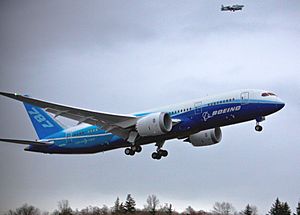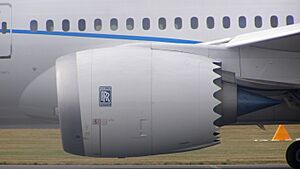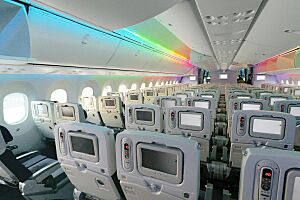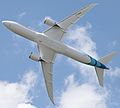Boeing 787 Dreamliner facts for kids
Quick facts for kids Boeing 787 Dreamliner |
|
|---|---|
 |
|
| The 787 right after takeoff on its first flight | |
| Role | Wide-body jet airliner |
| National origin | United States |
| Manufacturer | Boeing Commercial Airplanes |
| First flight | December 15, 2009 |
| Introduction | October 26, 2011 with All Nippon Airways |
| Status | Currently in production; in regular passenger airline service |
| Primary users | All Nippon Airways Japan Airlines Air India Qatar Airways |
| Produced | 2007–present |
| Number built | 228 in December 2014 |
| Unit cost | 787-8: US$ 211.8 million 787-9: US$249.5 million 787-10: US$288.7 million |
The Boeing 787 Dreamliner is a large passenger aircraft built by Boeing in the United States. Its first test flight was on December 15, 2009. The first time passengers flew on this plane was in October 2011. This was later than planned, causing some airlines to get their planes almost 30 months late.
The aircraft faced some challenges early on. Aviation groups like the FAA in the U.S. and the Japanese Transport Ministry looked into these issues. In January 2013, several countries temporarily stopped the 787s from flying. This was to make sure everything was safe for passengers.
Contents
History of the Dreamliner
In the late 1990s, Boeing thought about making a very fast plane called the Sonic Cruiser. But after the September 11 attacks in 2001, fuel prices went up a lot. Airlines then wanted planes that used less fuel, not faster ones.
So, Boeing stopped working on the Sonic Cruiser. In January 2003, they started a new project called the "7E7." This plane was designed to be much more fuel-efficient. In July 2003, Boeing decided to call this new plane the "Dreamliner."
On April 26, 2004, a Japanese airline called All Nippon Airways was the first to order the 7E7. They hoped to get the plane by 2008. In 2005, the plane's name was officially changed to the 787.
Building a Lighter Plane
The 787 was made to save a lot of fuel. Boeing did this by building most of the plane with composite materials instead of aluminum. Composite materials are lighter and stronger. The plane also uses two new types of engines: the General Electric GEnx and the Rolls-Royce Trent 1000. Boeing says these changes make the 787 use 20% less fuel than the older 767.
Delays and First Flight
In December 2006, Boeing announced that the 787 was heavier than they expected. This caused the first delay. Boeing also tried a new way to build the plane. They asked other companies to put together large parts of the plane. These companies were not used to this much work, which caused even more delays.
Boeing started testing the 787 on the ground. They found more issues, leading to more delays. Finally, on December 15, 2009, the 787 made its first flight. Boeing then began testing the plane in the air. There were still some problems, like an engine issue and a small fire during a test flight. These events caused even more delays. Some airlines wanted money back because of all the waiting. In July 2011, Boeing delivered the first 787 to ANA.
Cool Features of the 787
Pilots who fly the Boeing 777 can easily learn to fly the 787. This is because both planes have a "common type rating." It means pilots need very little extra training to switch between them.
One neat part of the 787 is the special sawtooth shape at the back of its engines. Boeing says this design helps make the plane quieter for people inside and on the ground. The engines also have special material at the front to absorb sound, making the plane even more quiet.
The inside of the 787 is also very special. The windows are much bigger than on other planes. This is possible because the plane is made mostly of strong composite materials. Also, the windows don't have pull-down shades. Instead, they have buttons that let you dim the window from clear to very dark. The plane's inside also uses LED lights. This allows the plane to change the colors of the lights in the cabin.
More Comfort for Passengers
Because the plane is made of strong composites, passengers can feel more comfortable. Most planes fly so high that they need to pump air into the cabin. This makes passengers feel like they are at about 8,000 feet (2,400 meters) high. But the 787 can pump in more air, making passengers feel like they are at about 6,000 feet (1,800 meters). This is closer to sea level, which can make long flights feel better.
The composite material also resists corrosion (like rust) better than aluminum. This means the plane can have higher humidity inside. Boeing says these improvements will help passengers feel less tired after a long flight.
Different Types of Dreamliners
Boeing makes three main types, or "variants," of the Dreamliner: the 787-8, the 787-9, and the 787-10. The 787-10 is still being tested. Boeing had planned to make a fourth type, the 787-3, but it was cancelled because airlines didn't order enough of them.
787-8
The 787-8 is the shortest Dreamliner. It can carry about 210 people and fly about 15,200 km (9,445 miles). It started flying with airlines in 2011. The 787-8 is designed to replace older planes like the Boeing 767-200ER and Boeing 767-300ER. It's best for very long flights with fewer passengers, where a bigger plane might not be needed.
787-9
The 787-9 is a longer version of the Dreamliner. It can fly about 270 people and has a range of about 15,750 km (9,787 miles). Production of this model started in 2014. It can carry more weight and is longer than the 787-8. It competes with planes like the Airbus A330-300 and A330-200. It will replace the Boeing 767-400ER.
787-10
The 787-10 is the longest Dreamliner variant. It can carry about 300 people. Because it's so big, it has a shorter range than the other 787s. It competes with the Airbus A350 and will replace planes like the Boeing 777-200ER.
787-3 (Cancelled)
The 787-3 was planned to be the smallest Dreamliner. It would have had the shortest range at about 5,000 km (3,100 miles). It was designed to carry about 290 people. This version was meant to replace planes used for short flights within Japan. Two Japanese airlines had ordered the 787-3. But because of the many delays, these airlines cancelled their orders. This led Boeing to stop making the 787-3.
| Boeing 7x7 aircraft timeline, 1955–now | ||||||||||||||||||||||||||||||||||||||||||||||||||||||||||
|---|---|---|---|---|---|---|---|---|---|---|---|---|---|---|---|---|---|---|---|---|---|---|---|---|---|---|---|---|---|---|---|---|---|---|---|---|---|---|---|---|---|---|---|---|---|---|---|---|---|---|---|---|---|---|---|---|---|---|
| 1950s | 1960s | 1970s | 1980s | 1990s | 2000s | 2010s | ||||||||||||||||||||||||||||||||||||||||||||||||||||
| 1955 | 1956 | 1957 | 1958 | 1959 | 1960 | 1961 | 1962 | 1963 | 1964 | 1965 | 1966 | 1967 | 1968 | 1969 | 1970 | 1971 | 1972 | 1973 | 1974 | 1975 | 1976 | 1977 | 1978 | 1979 | 1980 | 1981 | 1982 | 1983 | 1984 | 1985 | 1986 | 1987 | 1988 | 1989 | 1990 | 1991 | 1992 | 1993 | 1994 | 1995 | 1996 | 1997 | 1998 | 1999 | 2000 | 2001 | 2002 | 2003 | 2004 | 2005 | 2006 | 2007 | 2008 | 2009 | 2010 | 2011 | 2012 | 2013 |
| Boeing 707 | ||||||||||||||||||||||||||||||||||||||||||||||||||||||||||
| Boeing 717 (MD-95) | ||||||||||||||||||||||||||||||||||||||||||||||||||||||||||
| Boeing 727 | ||||||||||||||||||||||||||||||||||||||||||||||||||||||||||
| Boeing 737 | ||||||||||||||||||||||||||||||||||||||||||||||||||||||||||
| Boeing 747 | ||||||||||||||||||||||||||||||||||||||||||||||||||||||||||
| Boeing 757 | ||||||||||||||||||||||||||||||||||||||||||||||||||||||||||
| Boeing 767 | ||||||||||||||||||||||||||||||||||||||||||||||||||||||||||
| Boeing 777 | ||||||||||||||||||||||||||||||||||||||||||||||||||||||||||
| Boeing 787 | ||||||||||||||||||||||||||||||||||||||||||||||||||||||||||
| = Not being made anymore | = Still being made | |||||||||||||||||||||||||||||||||||||||||||||||||||||||||
Images for kids
-
All Nippon Airways flew the first commercial 787 flight on October 26, 2011.
-
A defunct subsidiary of Norwegian Air Shuttle, Norwegian Long Haul operated the 787 as a long-haul low-cost carrier.
-
Qatar Airways 787-8 business class cabin in 1-2-1 layout
-
United Airlines was the North American launch customer for all three 787 variants.
-
The longer 787-9 (206 ft, 62.8 m) was introduced by Air New Zealand on August 9, 2014
-
The 787-10 began commercial service on April 3, 2018, with Singapore Airlines
-
The 787-3 would feature a reduced wingspan with wingtip devices
-
Japan Airlines 787-8 applying reverse thrust on a wet runway
-
Three 787s of All Nippon Airways sit grounded at Tokyo Haneda International Airport in late January 2013.
-
N787BA, the first prototype aircraft, on display in the "Flight of Dreams" building at Chubu Centrair Airport, Nagoya
See also
 In Spanish: Boeing 787 para niños
In Spanish: Boeing 787 para niños



































